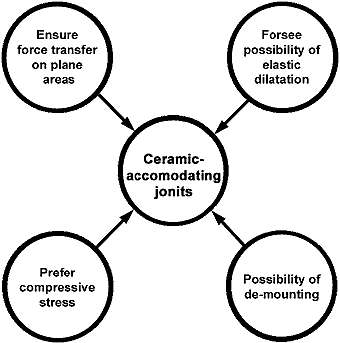8.1 Principles
The materials to be bonded and the
demands to be placed on the bond are crucial for the
choice of bonding technique.
Design appropriate for ceramics means, for example,
that when bonded with metals, the ceramic should be
placed under compressive stress whenever possible, and
that tensile or bending loads be transferred to the
metal
|
 Figure 185:
Figure 185: Factors affecting joints |
The behaviour of the functional unit
takes the primary focus in every case. The reliability of
the bond must be guaranteed against overloading and loosening
during manufacture and use. The main task of the designer
is to match the plastic, elastic, thermal and geometric expansion
differences between this ceramic component and its surroundings.
The suitability of the joining technique or combination of
techniques is decided on a case-by-case basis. Joining is
more than just a matter of adapting the expansion coefficient
and elastic modulus. The interaction of material data, part
design and contact surfaces demands close, multi-disciplinary
cooperation between technologists, manufacturing technicians
and constructors, particularly in order to overcome the internal
stresses of the combined materials.
The designer should proceed in a manner suitable for the materials,
and should pay attention to the following basic rules:
- avoid stress concentrations and point-loads by
o using large areas to apply forces,
o parallel contact surfaces,
o using elastic intermediate layers where appropriate and
o force transfer without acute changes of direction.
- avoiding tensile stress in the ceramic part and preferring
compressive stress by:
o press-fit joints (ceramic part on the inside),
o compressive pre-stressing
o properly arranged load application points.
- avoiding impact or shock stress by:
o applying loads over larger areas,
o reducing applied load
o supplying additional resilient, elastic and / or damping
elements.
- avoiding additional stress resulting from constrained
thermal expansion by using
o materials with similar thermal expansion coefficients,
o resilient or elastic elements and
o air gaps.
- compensation of differences in deformation resulting
from differing elastic moduli (if they increase the stress
on the ceramic part) by:
o resilient or elastic intermediate elements and
o matching the stiffnesses.
- Interlock/frictional jointing
o geometrical interlocks avoid the need for further fasteners.
o Frictional bonding compensates problems due to differences
in thermal expansion coefficient and stiffness
|
|

